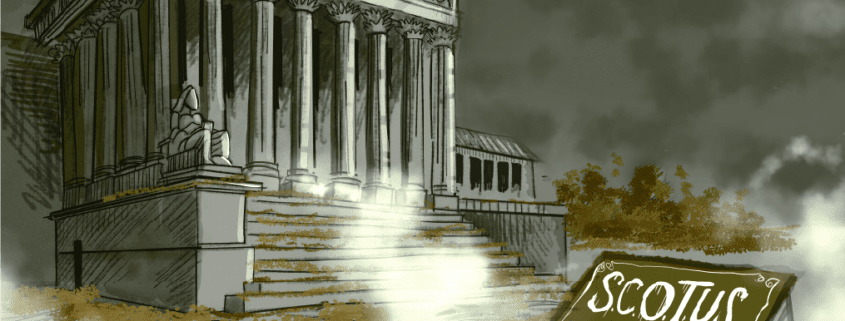Use of “Shadow Docket” is undermining public trust in the Supreme Court
 The inner workings of the U.S. Supreme Court have been veiled in secrecy since Chief Justice John Jay gaveled the first meeting of the tribunal to order 1789. Aside from hearing oral arguments and issuing decisions, the nine justices function behind tightly closed doors. The conferences in which they debate cases are conducted in private and no notes or minutes are kept, memos and communications by and between the justices are not subject to the Freedom of Information Act, each justice has the sole power to release or conceal their papers, and law clerks sign iron-clad confidentiality agreements. No other branch of government is so immune to public scrutiny.
The inner workings of the U.S. Supreme Court have been veiled in secrecy since Chief Justice John Jay gaveled the first meeting of the tribunal to order 1789. Aside from hearing oral arguments and issuing decisions, the nine justices function behind tightly closed doors. The conferences in which they debate cases are conducted in private and no notes or minutes are kept, memos and communications by and between the justices are not subject to the Freedom of Information Act, each justice has the sole power to release or conceal their papers, and law clerks sign iron-clad confidentiality agreements. No other branch of government is so immune to public scrutiny.
In 1955 Justice Felix Frankfurter offered this explanation for why the Court’s work must be concealed from view:
“The secrecy that envelops the Court’s work is not due to love of secrecy or want of responsible regard for the claims of a democratic society to know how it is governed. That the Supreme Court should not be amenable to the forces of publicity to which the Executive and the Congress are subjected is essential to the effective functioning of the Court.”
The veil that shrouds the Court has occasionally been pierced. Bob Woodward and Scott Armstrong’s “The Brethern: Inside the Supreme Court” published in 1979 provided the first in-depth, behind-the-scenes look at the Court thanks to Justice Potter Stewart who was the primary source for the book. In 2004, Vanity Fair reporter David Margolis persuaded several clerks to reveal the political machinations that led to the Court’s controversial decision in Bush v Gore and last year CNN’s Joan Biskupic used confidential sources inside the court to produce a number of pieces about the term’s most-watched cases.
 Despite these notable breaches, respect for the Court’s need to operate clandestinely has remained largely intact because even though the sometimes-messy process of judicial sausage-making has been concealed behind what is commonly referred to as the “Purple Curtain,” the end product has always been prominently displayed in the form of majority and dissenting opinions that clearly reveal the justices’ reasoning and positions. Those opinions—millions of pages of them—are the foundation of the American legal system. They are also the reason why the Court has always been held in high esteem by the public.
Despite these notable breaches, respect for the Court’s need to operate clandestinely has remained largely intact because even though the sometimes-messy process of judicial sausage-making has been concealed behind what is commonly referred to as the “Purple Curtain,” the end product has always been prominently displayed in the form of majority and dissenting opinions that clearly reveal the justices’ reasoning and positions. Those opinions—millions of pages of them—are the foundation of the American legal system. They are also the reason why the Court has always been held in high esteem by the public.
Unfortunately, in recent years the Court has repeatedly abandoned the slow, deliberative process that produced well-argued landmark decisions and precedents in favor of what University of Chicago Law School professor William Baude refers to as the “Shadow Docket”—unsigned opinions issued hastily without detailed explanations, often before the cases in question have worked their way through the federal district and appellate courts. The 6-3 ruling that allowed Texas’ draconian anti-choice law to take effect is the most recent and troubling example of the Court’s increasing embrace of this tactic.
I am not raising the issue because I disagree with the majority in the Texas case and others that have been decided via the Shadow Docket, but because the justice’s refusal to share their rationale for their decisions threatens to undermine both the nation’s jurisprudence and public support for the Court which, according to Gallup, has fallen below 50% for only the third time in the past 20 years.
As an attorney, a legal scholar, and a citizen who believes our judicial system is both the heart and soul of our democracy, I fear what may happen if Americans lose faith in the Court. For the good of our nation, I pray that the justices abandon the Shadow Docket and once again share their wisdom, knowledge, and reasoning with us.


 Along with defining prosecutors’ role, the rules, laws, and Supreme Court decisions also set forth their responsibilities, which, according to the ABA’s CJS include the duty to “…make timely disclosure to the defense of all evidence or information known to the prosecutor that tends to negate the guilt of the accused or mitigates the offense…”
Along with defining prosecutors’ role, the rules, laws, and Supreme Court decisions also set forth their responsibilities, which, according to the ABA’s CJS include the duty to “…make timely disclosure to the defense of all evidence or information known to the prosecutor that tends to negate the guilt of the accused or mitigates the offense…”